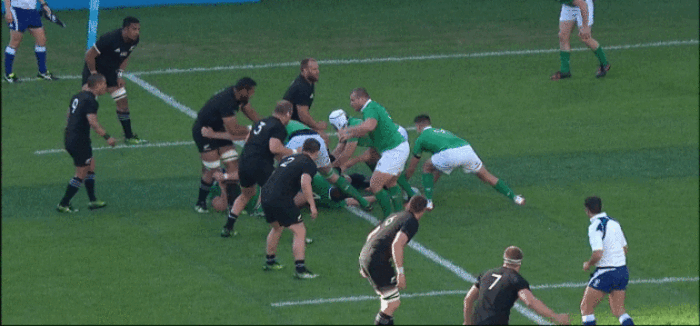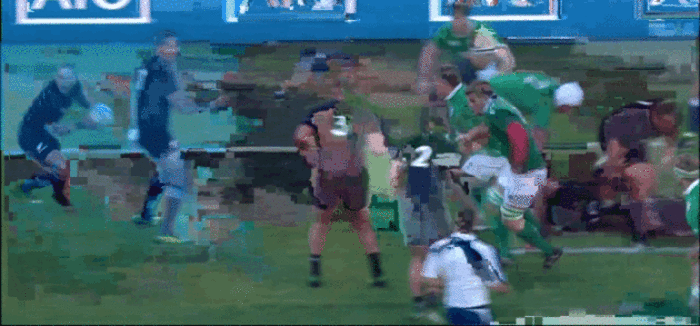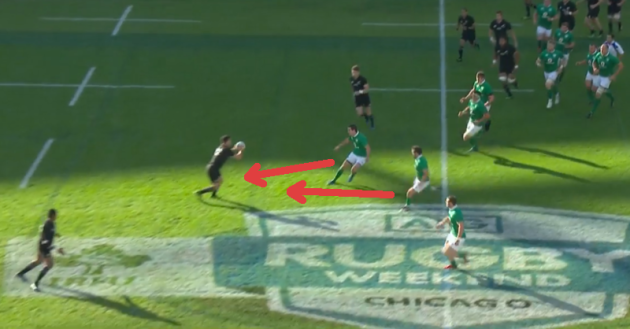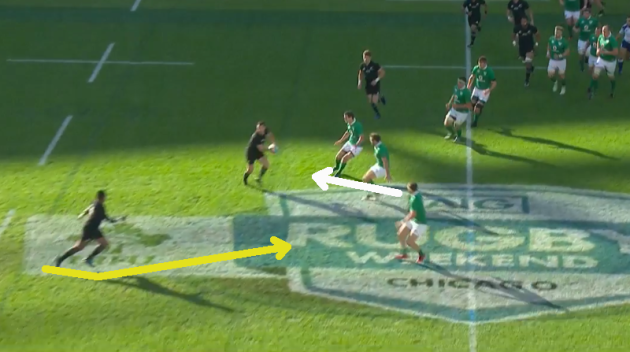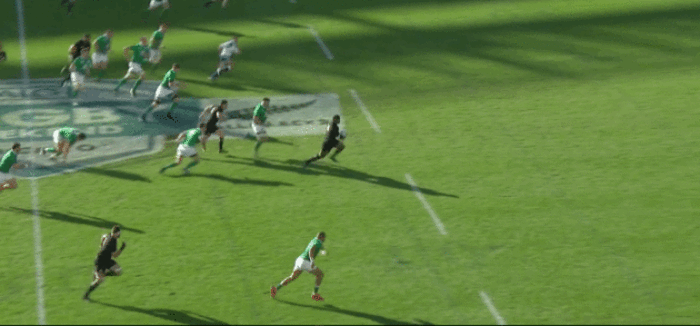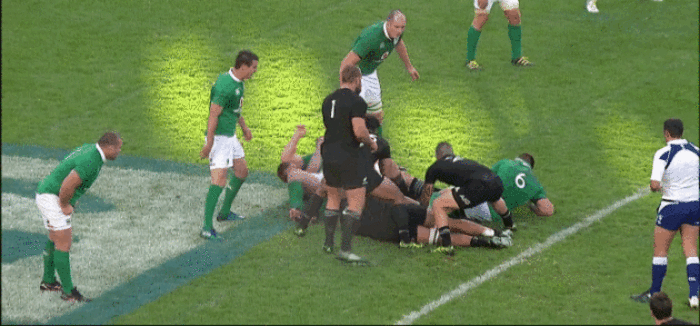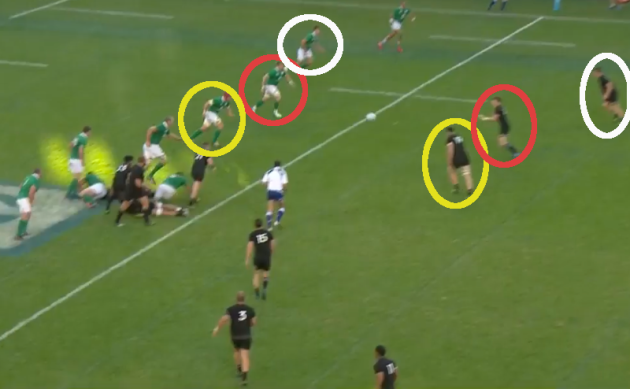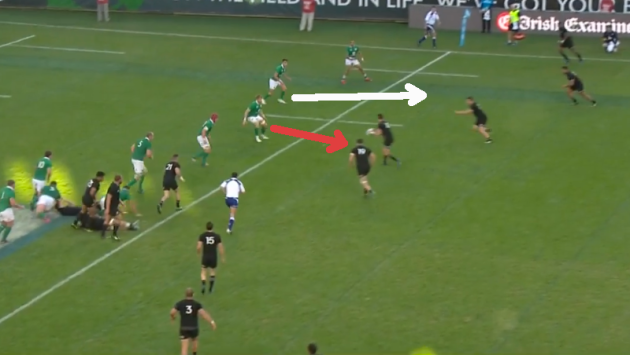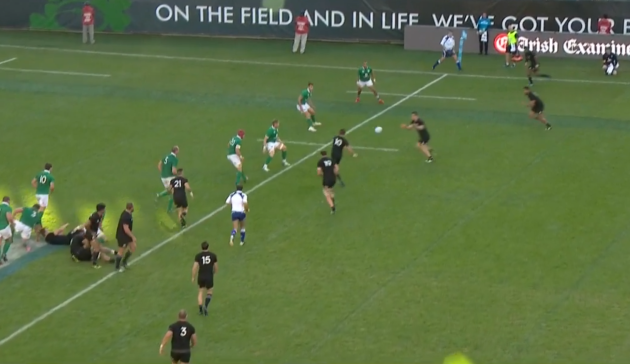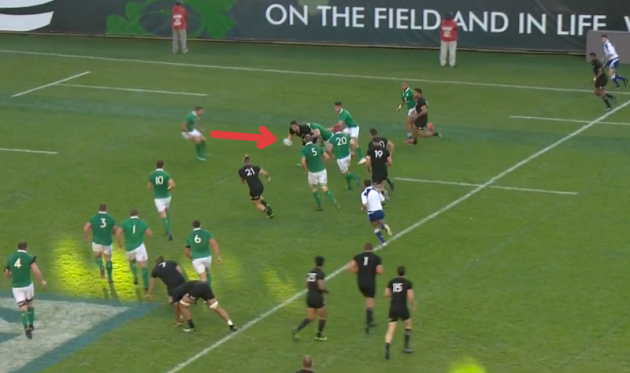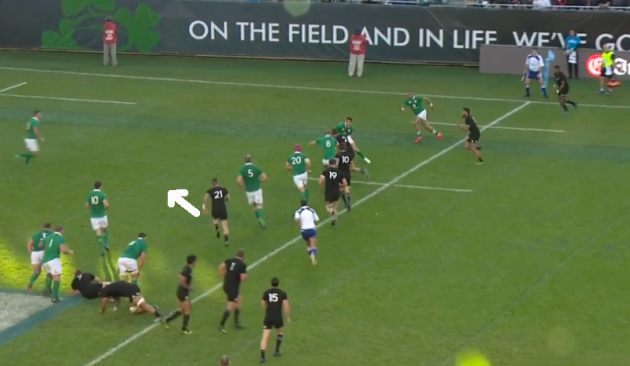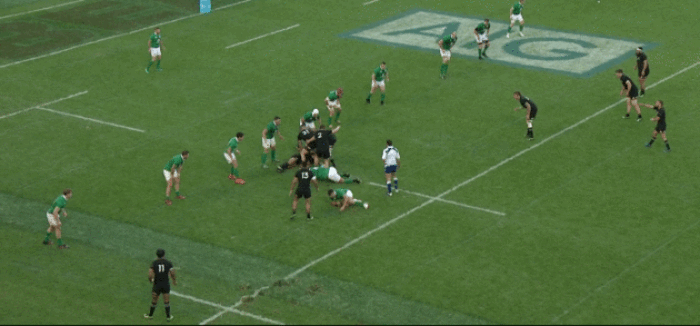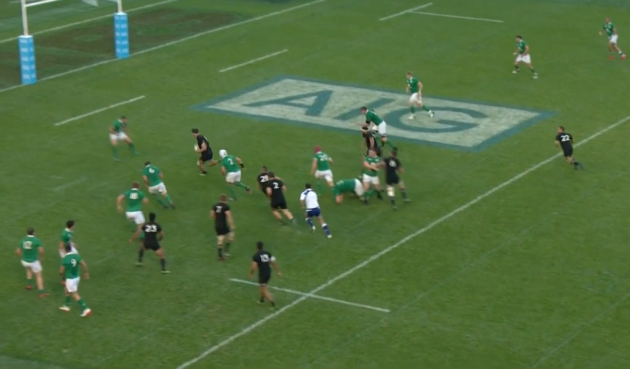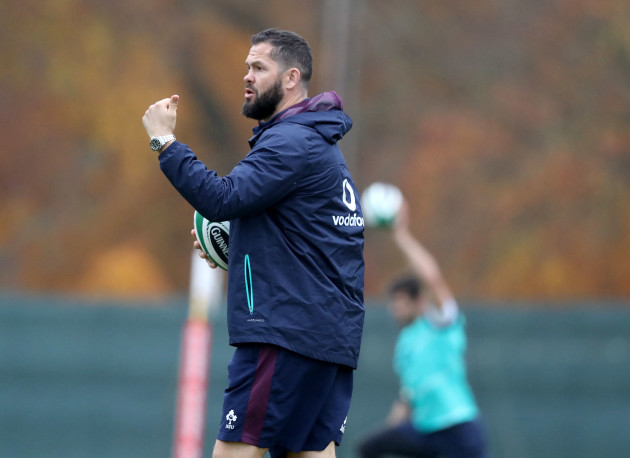PICKING HOLES IN Ireland’s performance in Chicago two weekends ago feels fussy, but Joe Schmidt, defence coach Andy Farrell and the players will have gone through every fault in detail.
While Ireland scored a remarkable five tries, they did give up four to the All Blacks and will have been disappointed with the manner of those scores.
While the defensive performance from Ireland was superb for long patches, as we have already discussed, there were minor slips that cost Schmidt’s side at Soldier Field.
Against the All Blacks, the tiniest disconnect in defence can make a massive difference and Ireland will have to be considerably closer to perfect today if they are to back up their history-making.
Early warning
George Moala’s early try in Chicago seemed extremely ominous at the time, although Ireland did superbly to steady themselves and gain dominance of the game and the scoreboard for the rest of the first half.
This try is a fine example of the Kiwis’ ability to ruthlessly exploit the smallest of inaccuracies in the defence. The platform is a kick return from an Ireland box kick, which Schmidt is likely to have looked at.
It’s one of many excellent kicks from Conor Murray in this first Test, as he gets almost five seconds of hang time – a huge boot.
But Ireland will have been disappointed not to get off the ground to contest in the air, as Schmidt pushes them so hard to do.
Above, the ball is circled in red, while Ben Smith is in yellow and Andrew Trimble in white.
Smith has timed his arrival perfectly, allowing him to jump up and into the ball. The All Blacks fullback is ready to launch himself off the ground here.
Trimble, meanwhile, has done well to get through the shepherding efforts of Aaron Smith and Julian Savea but at the very last moment he appears to feel he has overrun the ball and doesn’t get off the ground.
Smith therefore gets the kind of clean, unchallenged aerial take that is anathema to Schmidt. Ireland’s aerial competition was largely superb in Chicago, but can they be even better in Dublin?
Ben Smith carries into contact and actually loses control of the ball, but Aaron Smith reacts well to scoop it up and rip a pass off to his right.
Defending on kick returns generally means the line will be somewhat disorganised, but Ireland’s midfield trio is intact on this occasion – even if Robbie Henshaw is outside Jared Payne.
This is Ireland’s first time defending in the game and they are intent on bringing the kind of linespeed they would have spoken about all week.
As we can see above, Johnny Sexton shoots up hard to target All Blacks inside centre Ryan Crotty [as marked in red], getting ahead of Payne and Henshaw outside him in the process [circled in white].
Ireland’s intention here is to stop the ball dead in midfield, denying the All Blacks any chance to shift the ball wide to the right, where there are very few defensive bodies in place.
Irland are not very interested in drifting across the pitch, despite the presence of Kieran Read and Moala wide on their left – out of shot in the image above.
That means that as Ireland come forward at pace, Sexton and Payne end up aligning on the same player in Crotty, as highlighted above.
That essentially leaves Henshaw in a one-on-one with Waisake Naholo.
Now in hindsight, it may have been more ideal for the players inside Henshaw to ease off their linespeed and start a drift, but the Irish system appears to have been to hammer up and close down the ball.
So it is that Henshaw is left to deal with Naholo. He is obviously aware of the players wide to his left, but in the instant above he is in a fine position.
His head is up and tracking his target, Naholo is to his outside shoulder, and Henshaw is coming forward at pace. It has all the hallmarks of an impending impact tackle.
But Henshaw – here is the tiny detail – takes one last glance inside to Crotty and the ball [white below], at almost the exact same split second as Naholo subtly changes his running line [yellow below].
It’s a tiny, tiny detail in a split second but it makes all the difference as Naholo’s subtle and intelligent line takes him to Henshaw’s inside shoulder.
By the time Henshaw’s gaze is back on Naholo a split second later, it’s already too late. The powerful wing is running at his exposed inside shoulder and Henshaw simply slips up beyond him.
Naholo’s burst of acceleration and slight arc back towards the right touchline takes him past Payne, although Sexton has worked across to provide something of a safety net.
However, we then see a skill that is crucial to the Kiwis, as Naholo fends Sexton.
When we carried out our analysis of New Zealand’s 60 tries in 2016 before the Chicago clash, the fend was highly apparent as a key skill for them, featuring in many of the passages of attack that led to their scores.
Ireland will have done more work in dealing with that, and we actually get a good example of an Irishman negating the fend just seconds later in this particular passage.
Having fended Sexton, Naholo is in the kind of position every defence has nightmares about – in behind your frontline, moving at pace and with vast swathes of space either side of the fullback.
“That’s always an unbelievably difficult tackle,” says fullback Rob Kearney of his miss in this instance. “People sometimes expect those to get made. When you’ve got Naholo with 20 metres either side of you, it’s difficult.”
The Highlanders wing swerves around Kearney, before Zebo does very well to slap down his second fend – note how quickly Naholo transfers the ball to his left hand to even attempt a right-handed fend – and wrap the Kiwi wing up.
There is clearly a large degree of luck involved in the All Blacks finishing this try, as Kieran Read heads the assist – the second time that has happened for the Kiwis this year – and Moala is opportunistic in scoring.
However, Ireland will have been disappointed to allow tiny details contribute to New Zealand breaching them in the first place.
Disconnect
For TJ Perenara’s try, Ireland again made only subtle miscalculations – barely even errors – but that is more than enough for the All Blacks to pounce.
Ireland are in good shape to the left of the ruck initially. The Kiwis have a man over on the outside edge, but with fullback Kearney sweeping across in behind, the Irish defence has the situation well covered.
The tiniest disconnect in the Ireland frontline results in a try, however, with the Kiwis’ skills ruthlessly exploiting it.
As Perenara passes the ball from the ruck, we have marked out the responsibilities of the Irish defenders to the left of the ruck.
As second defender out from the ruck – ‘A’, ’200′, ‘bodyguard’, whatever your team calls this role – Josh van der Flier’s job is to target the inside-pass option of Scott Barrett. This pair are marked in yellow.
Jamie Heaslip is third out from the ruck for Ireland and so his first duty is to take care of the All Blacks’ first receiver, Beauden Barrett. They’re marked in red.
Finally, fourth man out from the ruck for Ireland is Conor Murray and he must start on Dane Coles here, as marked in white.
Again, Ireland appear to be in good shape but the tiniest details make a huge difference.
Heaslip starts the phase just slightly outside Barrett, meaning that he turns his shoulder back inwards as the New Zealand out-half carries the ball to the line.
Meanwhile, Murray on his left appears to think that Heaslip is going to be able to drift across towards Coles at an early stage, so Murray turns out towards the touchline and initially drifts that way.
With Coles picking a straight line in between them, the danger is immediately clear when Barrett passes.
As we can seee above, Heaslip has been sat down by Barrett’s run and Murray is already gone well beyond where Coles is running to, and he therefore also sits down briefly.
Characteristically, Heaslip reacts rapidly to find his feet and get across towards Coles, but it’s already too late at this point. With Coles’ skillset so strong, he tucks the ball into his right hand to keep it away from Heaslip’s grasp.
Fullback Kearney has recognised the danger and approaches the frontline as he fears a linebreak from Coles.
But there is no recovering for Ireland. While the offload is obviously world-class from Coles, the try is equally about the simple support play of Perenara.
Like all the best scrum-halves, the Hurricanes man always moves up the pitch after passing, always anticipating the linebreak or offload.
Again, the deficiencies in Ireland’s defence are minor here, but against a team as skilled as the All Blacks, those subtle disconnects are almost always exploited.
The fatigue of playing Test rugby is obviously at play here too. For most teams, a hooker in Coles’ position would not be capable of identifying the chink of space, transferring the ball to his right arm and offloading expertly out of contact.
Many teams might not have their scrum-half running this intelligent support line. But the All Blacks invariably provide those things and the smallest defensive slips result in the concession of five points.
Spacing
The above score points to a slight issue in Ireland’s spacing, with Murray being just a hint too wide of Heaslip. For the Scott Barrett try, we saw something similar.
Again, Ireland appear to be in good shape at first glance, but again there is a tiny detail just off and the All Blacks exploit it.
As the third man out from the ruck, Cian Healy is occupied by first receiver Liam Squire -as indicated by yellow.
Just inside him, van der Flier must initially concern himself with threat of the pick and snipe from Coles – as indicated by white. Rory Best [white scrum cap] must hold his position as pillar in case Coles snipes and leaves up an inside pass.
Outside Healy, Devin Toner is lined up on Scott Barrett [blue arrow], although he also has some concern about Aaron Cruden tucked in behind.
The spacing between Healy and Toner is just off. We can see above that Toner is slightly wide of Healy and, with the helpful benefit of a freeze frame, the space for the attack is clear [marked in red].
That inaccurate spacing also means Toner starts on Barrett’s outside shoulder and, again, we’re going to see how a subtle shift of running line back against the grain can have such a major effect.
The tip-on pass from Squire is superb – this is another trait of New Zealand’s try-scoring passages – and as we can see above, Toner is now having to make up ground to turn back in to Barrett.
The debutant’s acceleration and power takes him through Toner’s arm. It’s the branch of the tree Barrett is able to go through, rather than having to deal with the trunk of Toner’s body.
Once Barrett is in behind, Kearney looks to be in a good position to fell him, but he misses his tackle.
“It was poor,” says Kearney. “I just planted a little bit too early and left my feet behind me. He sort of threw a half shimmy but I needed to stop him on that occasion.”
Indeed, we can see below that Kearney does plant early for his tackle.
There’s still a distance of at least three metres between the players as Kearney begins to plant his feet. As always, it’s easy to comment on this with freeze frames and multiple replays, as well as without the fatigue of top-level Test rugby in the limbs, but Kearney says he has worked hard on this detail in training since Chicago.
Next time, he will look to get his feet in close to the tackle point, dip and load his power, then accelerate through the hit with a firm wrap of the arms.
As with the other two examples, many sides wouldn’t have scored in this instance. Firstly, they probably wouldn’t have a debutant lock of Barrett’s athleticism, but they may also have lacked the clever running line and the delicate tip-on pass under pressure.
The Kiwis, however, have all those attributes and more. They will almost certinaly score tries again today in Dublin, meaning Ireland will need to bring even more in defence, pushing closer to perfection, if they are to cope.
The tiny details will have to be right more often than not.
“We looked back on that and we were fairly hard on ourselves in that performance,” says Rory Best of Ireland’s defence. “Faz [Andy Farrell] expects us to go out and to deliver.
“Not that he’s not concerned about the score, but he’s concerned about our systems and how we stop these tries.
“If a team does unbelievably well and pulls a rabbit out of a hat and scores a try, but our system is good, he’s reasonably happy. For us, when we look back on some of those scores and some of those breaks that we let New Zealand get away with, there’s a lot of improvements that we can make on our system.
“We’ve had three weeks together now, so we should be better defensively than we were in Chicago. Look, to beat the All Blacks you’re going to have to score some points but we also feel that defensively we need to be better and have to be better.
“Because they’re going to come with a bit more accuracy and it’s going to test our defence more. Again, it’s something we’re really looking forward to because they are a quality attacking outfit.
“We, especially since that South Africa tour, have really stepped up our defence and this will be an unbelievable challenge for us.”
- This article was originally published on 18 November, then updated at 9.55am on 19 November.
The42 is on Instagram! Tap the button below on your phone to follow us!
